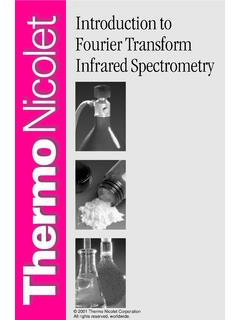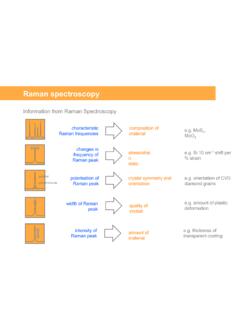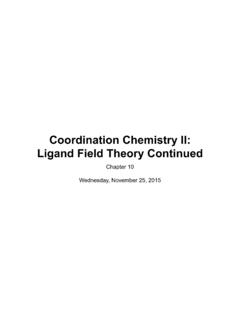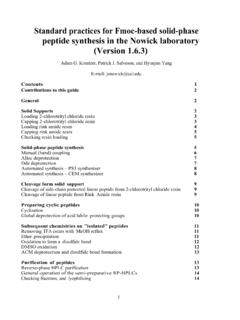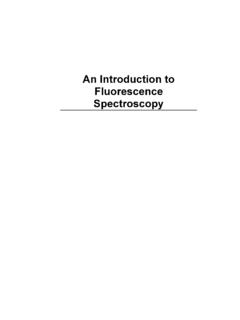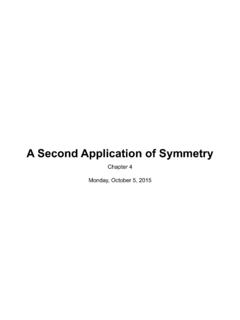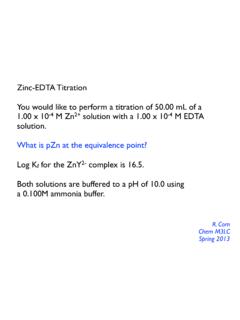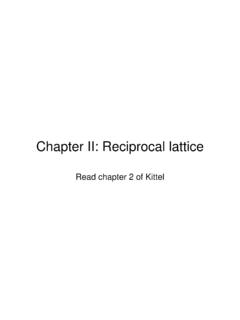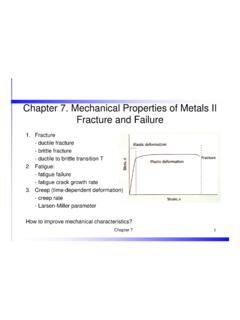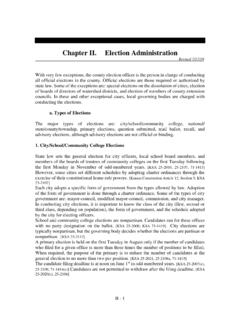Transcription of CHAPTER 10: COORDINATION CHEMISTRY II: BONDING
1 138 CHAPTER 10 COORDINATION CHEMISTRY II: BONDING Copyright 2014 Pearson Education, Inc. CHAPTER 10: COORDINATION CHEMISTRY II: BONDING a. Tetrahedral d 6, 4 unpaired electrons b. [Co(H2O)6]2+, high spin octahedral d 7, 3 unpaired electrons c. [Cr(H2O)6]3+, octahedral d 3, 3 unpaired electrons d. square planar d 7, 1 unpaired electron e. BM = = nn 2 ; n 4 a. [M(H2O)6]3+ with 1 unpaired electron. d1: M = Ti b. [MBr4] with the maximum number of unpaired electrons (5). M3+ with 5 d electrons: M = Fe c. Diamagnetic [M(CN)6]3 . The strong field cyano ligand favors low spin. M3+ with 6 d electrons: M = Co d. [M(H2O)6]2+ having LFSE = 35 o . Both high spin d4 and d9 have the correct o.
2 High spin d4: M = Cr d9: M = Cu a. K3[M(CN)6] M is first row transition metal, 3 unpaired electrons. M3+ with 3 d electrons: M = Cr CHAPTER 10 COORDINATION CHEMISTRY II: BONDING 139 Copyright 2014 Pearson Education, Inc. b. [M(H2O)6]3+ M is second row transition metal, LFSE = o. This can be achieved with a low spin d6 configuration. M3+ with 6 d electrons: M = Rh c. [MCl4] M is first row transition metal, 5 unpaired electrons. M3+ with 5 d electrons: Fe d. MCl2(NH3)2 M is third row d8 transition metal; two M Cl stretching bands in IR. Second and third row d8 complexes are often square planar. The presence of two M Cl stretching bands implies cis geometry of the chloro ligands.
3 M2+ with 8 d electrons: M = Pt PtClNH3NH3Cl Angular overlap calculations for d 8 and d 9 ions show no energy difference between D4h and Oh when exclusively considering interactions. Both d 8 geometries have energies of -3e ; both d 9 geometries have energies of -6e . In general, stability constants decrease as more ligands are added; the sequence for nickel is the common one. The huge drop in stability constant between the second and third ethylenediamine on Cu2+ is a result of the d 9 Jahn-Teller effect. The first two en ligands add in a square-planar geometry, with water molecules in the axial positions, and the COORDINATION of these two mondentate ligands allows for the Jahn-Teller distortion. Adding a third en ligand requires a geometry change and with a preference for uniform M N bond distances towards the six nitrogen atoms.
4 This is counter to the Jahn-Teller distortion, and the third addition is much less favorable than the first two. [M(H2O)6]2+ M is first row transition metal, = BM. The magnetic moment implies 3 unpaired electrons, which would give rise to 33 5 = BM. There are two possibilities, d3 and d7: M2+ , d3 : M = V M2+ , d7: M = Co a. [Cr(H2O)6]2+ n = 4 4(6) B b. [Cr(CN)6]4 n = 2 2(4) B c. [FeCl4] n = 5 5( 7) B d. [Fe(CN)6]3 n = 1 1( 3) B e. [Ni(H2O)6]2+ n = 2 2(4) B f. [Cu(en)2(H2O)2]2+ n = 1 1( 3) B140 CHAPTER 10 COORDINATION CHEMISTRY II: BONDING Copyright 2014 Pearson Education, Inc. Fe(H2O)4(CN)2 is really [Fe(H2O)6]2[Fe(CN)6], all containing Fe(II).
5 [Fe(H2O)6]2+ is high spin d 6, with = B; [Fe(CN)6]4 is low spin d 6 , with = 0 B. The average value is then 2 = B. unpaired electrons gives B. Co(II) is d 7. In tetrahedral complexes, it is generally high spin and has 3 unpaired electrons; in octahedral complexes, it is also typically high spin and also has 3 unpaired electrons; in square planar complexes, it has 1 unpaired electron. The magnetic moments can be calculated as n(n 2) , , and B, respectively. For the red compounds (Me and Et at high temperatures, Pr, pip, and pyr at all temperatures), the larger magnetic moment indicates approximately 5 unpaired electrons, appropriate for high-spin Fe(III) species. At low temperatures for the Me and Et compounds, the magnetic moment indicates 3 to 4 unpaired electrons, an average value indicating an equilibrium mixture of high and low spin species.
6 The low spin octahedral complexes have 1 unpaired electron. Increasing the size of the R groups changes the structure enough that it is locked into high-spin species at all temperatures. Both [M(H2O)6]2+ and [M(NH3)6]2+ should show the double-humped curve of Figure , with larger values for the NH3 compounds. Therefore, the difference between these curves shows the same general features as in Figure These can be verified using the approach introduced in Chapters 4 and 5, in which a character of +1 is counted for each operation that leaves a vector unchanged, a character of 1 for each operation that leaves a vector in its position, but with the direction reversed. The general transformation matrix for rotation is provided in Figure Application is of this matrix is necessary to deduce the characters involving rotations.
7 The e column gives d orbital energies for complexes involving donor ligands only; the Total column gives energies for complexes of ligands that act as both donors and acceptors: a. ML2, using positions 1 and 6: e e Total z2 2 0 2e x2 y2 0 0 0 xy 0 0 0 xz 0 2 2 e yz 0 2 2 e b. ML3, using positions 2, 11, 12: e e Total z2 0 x2 y2 e e xy e e xz 0 e yz 0 e CHAPTER 10 COORDINATION CHEMISTRY II: BONDING 141 Copyright 2014 Pearson Education, Inc.
8 C. ML5, C4v, using positions 1, 2, 3, 4, 5: e e Total z2 2 0 2e x2 y2 3 0 3e xy 0 4 4e xz 0 3 3e yz 0 3 3e d. ML5, D3h, using positions 1, 2, 6, 11, 12: e e Total z2 0 x2 y2 e e xy e e xz 0 e yz 0 e e. ML8, cube, positions 7, 8, 9, 10, doubled for the other four corners: e e Total z2 0 e x2 y2 0 e xy e e xz e e yz e e Metal d orbitals, NH3 influence Metal d orbitals, Cl influence e e Total z2 2 0 2e x2 y2 0 0 0 xy 0 0 0 xz 0 2 2 e yz 0 2 2 e Ligand NH3.
9 Ligand Cl : Overall energy = 8 e (NH3) 4 e (Cl) 8 e (Cl) + 4 e (Cl) = 8 e (NH3) 4 e (Cl) 4 e (Cl) The metal electrons are still unpaired, one in the dxy orbital and one each in the dxz and dyz, raised by interaction with Cl . Four of the ligand orbitals are lowered by e (NH3) and two are lowered e e Total z2 1 0 1e x2 y2 3 0 3e xy 0 0 0 xz 0 0 0 yz 0 0 0 e Total 1 0 0 2 1 1e 3 1 1e 4 1 1e 5 1 1e 6 0 0 e e Total 1 1 2 1e 2 e 2 0 0 0 3 0 0 0 4 0 0 0 5 0 0 0 6 1 2 1e
10 2 e 142 CHAPTER 10 COORDINATION CHEMISTRY II: BONDING Copyright 2014 Pearson Education, Inc. by e (Cl) + 2 e (Cl); each contains a pair of ligand electrons. The precise orbital energies cannot be calculated since the angular overlap parameters for NH3 and Cl towards Cr(III) are not provided. Table does provide the necessary parameters for trans-[Cr(NH3)4F2]+. a. If we assume these ligands have similar donor abilities, the energies below are obtained for the molecular orbitals with high d orbital character. metal d b. For consideration of Las a -acceptor in the axial position, the identical energy level diagram is obtained regardless of whether L is assigned to position 1 or 6. The xz and yz orbitals are each stabilized by e . e metal d orbitals For consideration of L in an equatorial position, the angular overlap result is different depending on whether the -acceptor is placed in position 2 or position 11/12.

